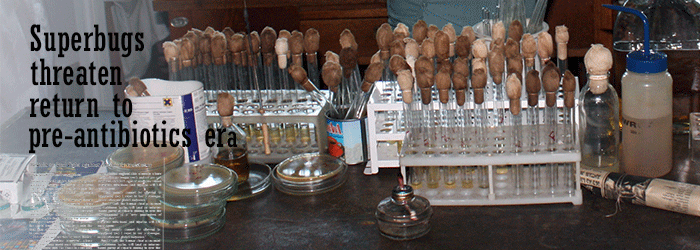
Avoiding a Return to the Pre-antibiotics Era
Prior to the discovery of antibiotics infected minor cuts and scrapes could result in amputation, or worse. Nowadays, with the overuse of antibiotics, particularly in the meat and poultry industries, bacteria are rapidly becoming resistant to all classes of antibiotics. When a new antibiotic is developed, the bacteria -- often referred to as superbugs -- mutate so quickly they are resistant to the antibiotic before very costly clinical trials are completed. Those antibiotics that do make it through the clinical trial process may have serious side-effects and use is often restricted by the FDA. Because of the cost-prohibitive regulatory processes and lowered profit margins, pharmaceutical companies have abandoned development of new classes of antibiotics.
Our Solution: Broad Spectrum Bacteriophage Cocktails
To address the problem of antibiotic resistance Theralytix has developed four broad spectrum polyvalent bacteriophage cocktails. While the company will initially manufacture branded products for human use, the phage components are available to third parties for use in all relevant verticals.
The Bacterial Pathogens We Are Targeting
Acinetobacter baumanii
is a gram-negative, opportunistic bacterium known for causing severe infections like pneumonia, bloodstream infections, and wound infections, particularly in hospital settings. Its multidrug-resistant strains, often resistant to most antibiotics, pose a significant global health threat, complicating treatment and increasing mortality rates.
Enterococcus spp.
species are notably Enterococcus faecalis and Enterococcus faecium, are gram-positive bacteria that cause infections such as urinary tract infections, endocarditis, and sepsis, often in healthcare settings. Their increasing resistance to antibiotics, particularly vancomycin (VRE), complicates treatment, making alternatives like phage therapy, discussed previously, a promising approach for resistant strains.
Escherichia coli
(E. coli) is a gram-negative bacterium commonly found in the human gut, but certain pathogenic strains, like E. coli O157:H7, can cause severe foodborne illnesses, urinary tract infections, or kidney infections, potentially leading to sepsis (as discussed previously). Multidrug-resistant strains are a growing concern, prompting exploration of alternative treatments like phage therapy, which targets specific bacteria to mitigate infections.
Klebsiella spp.
species, particularly Klebsiella pneumoniae, are gram-negative, opportunistic bacteria that commonly cause hospital-acquired infections such as pneumonia, urinary tract infections, and bloodstream infections. Their increasing multidrug resistance, including to carbapenems, makes them a significant global health concern, often requiring advanced treatments like phage therapy to combat infections.
Proteus spp.
species are primarily Proteus mirabilis and Proteus vulgaris, are gram-negative bacteria commonly associated with urinary tract infections, particularly in catheterized patients, and can contribute to kidney infections or sepsis if untreated. Their ability to produce urease and form biofilms enhances their pathogenicity and antibiotic resistance, making alternative treatments like phage therapy (discussed previously) a potential option for resistant strains.
Pseudomonas aeruginosa
is a gram-negative, opportunistic bacterium notorious for causing severe infections like pneumonia, bloodstream infections, and urinary tract infections, particularly in immunocompromised patients or those in healthcare settings. Its high antibiotic resistance, including to multiple drug classes, complicates treatment, making alternative approaches like phage therapy (discussed previously) a promising option for resistant strains.
Salmonella spp.
species are gram-negative bacteria that primarily cause foodborne illnesses, such as salmonellosis, characterized by diarrhea, fever, and abdominal cramps. Certain strains, like Salmonella Typhi, can lead to severe systemic infections like typhoid fever, requiring antibiotic treatment or, in resistant cases, alternative approaches like phage therapy.
Shigella spp.
species are gram-negative bacteria that cause shigellosis, a highly contagious intestinal infection characterized by severe diarrhea, fever, and abdominal pain, often spread through contaminated food or water. Increasing antibiotic resistance in strains like Shigella sonnei and Shigella flexneri complicates treatment, making alternative therapies like phage therapy (discussed previously) a potential option for resistant cases.
Staphylococcus spp.
Staphylococcus species are gram-positive bacteria, with Staphylococcus aureus being a leading cause of infections ranging from skin and soft tissue infections to severe conditions like pneumonia and sepsis, often linked to hospital settings. Multidrug-resistant strains, such as MRSA, complicate treatment, making alternatives like phage therapy (discussed previously) a potential solution for resistant infections.
Streptococcus spp.
species are gram-positive bacteria that cause a wide range of infections, from mild conditions like strep throat (Streptococcus pyogenes) to severe diseases such as pneumonia, meningitis, and sepsis. Increasing antibiotic resistance in some strains, like Streptococcus pneumoniae, poses treatment challenges, prompting interest in alternative approaches like phage therapy, as discussed previously for resistant infections.
Some Infectious Disease Statistics
Per the peer-reviewed journal BMC viral respiratory infections in COVID-19 patients predispose them to bacterial infections, and these co-infections have a worse outcome than either infection on its own.
According to CDC’s “Biggest Threats and Data” 2019 Antibiotic Resistance Threats Report, more than 2.8 million antibiotic-resistant infections occur in the U.S. each year, and more than 35,000 people die as a result. In addition, 223,900 cases of Clostridium difficile occurred in 2017 and at least 12,800 people died.
10% of the global population suffer with chronic, biofilm-based infections that do not respond to antibiotics. Among these are urinary tract infections, sinusitis, non-healing wounds and many similar bacteria-caused medical conditions.
In 2017 almost 1.6 million people died from diarrheal diseases. This is more than all deaths from all ‘intentional injuries’ combined in the same year. Diarrheal disease was the cause of every tenth child's death in 2017 -- more than half a million of the 5.4 million children that died in 2017 died from diarrheal disease.
But small is the gate and narrow the road that leads to life, and only a few find it.
